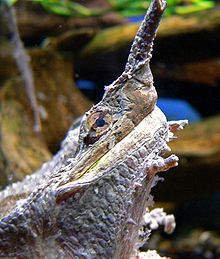Mata mata
| Mata mata Temporal range:
| |
|---|---|

| |
| In Shanghai Aquarium, China | |
| Scientific classification | |
| Domain: | Eukaryota |
| Kingdom: | Animalia |
| Phylum: | Chordata |
| Class: | Reptilia |
| Order: | Testudines |
| Suborder: | Pleurodira |
| Family: | Chelidae |
| Genus: | Chelus |
| Species: | C. fimbriata
|
| Binomial name | |
| Chelus fimbriata (
Schneider, 1783)[3] | |
| Synonyms[1][6] | |
|
Species synonymy
| |
The mata mata, mata-mata, or matamata (Chelus fimbriata)
Taxonomy
The mata mata first became known to western scientists when it was described by French
In 1995, distinct morphological differences were found between the populations of the Amazon and Orinoco basins.[12] In 2020, this was supported by a genetic analysis, which showed a deep split between two of its populations. The authors proposed that the mostly Orinoco population be assigned to a new species, Chelus orinocensis, with the Amazon population retaining the Chelus fimbriatus. However, Chelus fimbriatus is absent from the upper Rio Negro–Branco system (the northernmost part of the Amazon basin), which instead is inhabited by Chelus orinocensis.[8]
Anatomy and morphology

The mata mata is a large, sedentary turtle with a large, triangular, flattened head with many
The mata mata's brown or black, oblong
Each forefoot has five webbed claws. Males have concave plastrons and longer, thicker tails than females.[13]
Habitat
The mata mata inhabits slow moving streams,
Behavior


The appearance of the mata mata's shell resembles a piece of bark, and its head resembles fallen leaves.
Reproduction
Males display for females by extending their limbs, lunging their heads toward the females with mouths agape, and moving the lateral flaps on their heads. Nesting occurs from October through December in the
Diet
This section needs expansion. You can help by adding to it. (March 2018) |
The mata mata is carnivorous, feeding almost exclusively upon aquatic
Mata mata turtles use a specific method of seizing their prey. They will move the prey into shallower areas of water, surround the prey, and wave their front legs to prevent them from escaping. Once surrounded, the mata mata turtles will open their mouths and contract their pharynx, causing a rush of water that pushes the prey into their mouth.[23]
In captivity

Mata mata turtles are readily available in the exotic pet trade and are quite expensive to obtain. Due to their unique appearance, they make interesting display animals. They also grow quite large. However, mata matas are not active hunters, so, like the alligator snapping turtle, they need less space than a large, active species.
As with all aquatic turtles, water quality is one of the keys to keeping this species successfully in captivity. Warm, acidic water is the best type used with a high
References
- ^ ISBN 978-1-5323-5026-9.
- ^ "Appendices | CITES". cites.org. Retrieved 2023-03-01.
- ^ a b Schneider, J.G. 1783. Allgemeine Naturgeschichte der Schildkröten, nebst einem Systematischen Verseichnisse der einzelnen Arten. Müller, Leipzig. xlviii + 364 p.
- ^ ICZN. 1963. Opinion 660. Suppression under the plenary powers of seven specific names of turtles (Reptilia: Testudines). Bulletin of Zoological Nomenclature 20:187-190.
- ^ Duméril, A.M.C. 1806. Zoologie Analytique, ou Méthode Naturelle de Classification des Animaux. Paris: Perronneau, 344 pp.
- S2CID 87809001.
- ^ Giant fossil matamata turtles (matamatas part V) Archived 2011-10-11 at the Wayback Machine, Tetrapod Zoology
- ^ S2CID 215751367.
- ^ a b c Espenshade III, William H (1990), "Matamata, Chelus fimbriatus", Tortuga Gazette, 26 (5): 3–5
- ^ a b Chelus fimbriata, The Reptile Database
- ^ Matamata, Chelus fimbriatus, California Turtle & Tortoise Club
- ^ Sanchez-Vilaga, Marcelo R.; Prichard, Peter C. H.; Paolillo, Alfredo; Linares, Omar J. (January 1995). "Geographic variation in the matamata turtle, Chelus fimbriatus, with observations on its shell morphology and morphometry" (PDF). Chelonian Conservation and Biology. 1: 292–300.
- ^ a b c d e f Bartlett, Dick (2007), "The Matamata", Reptiles Magazine, 15 (12): 18–20
- ^ a b (in French) Toutes les tortues du monde by Franck Bonin, Bernard Devaux and Alain Dupré, second edition (1998), editions Delachaux and Niestlé/WWF.
- ^ Encyclopedia of Animals: Mammals, Birds, Reptiles and Amphibians, Harold G. Cogger, Edwin Gould, Joseph Forshaw
- ^
Rosenfeld, Arthur (1989), Exotic Pets, New York: ISBN 978-0-671-47654-0
- ^ a b c d e
ISBN 978-0-8317-2786-4
- ^ "Mata Mata Turtle: Care Guide & Species Profile". 22 February 2022.
- ^ "Mata mata turtle, Chelus fimbrata, care sheet". 14 April 2020.
- ^ UWI St. Augustine. Retrieved 2023-12-16.
- ^ "Matamata - the Animal Facts - Habitat, Appearance, Diet, Behavior".
- ^ Fogel, David (2011). Matamatas: The Natural History, Captive Care and Breeding of Chelus fimbriatus. Turtle and tortoise preservation Group Turtles of the world series.
- JSTOR 1564454.)
{{cite journal}}: CS1 maint: multiple names: authors list (link) CS1 maint: numeric names: authors list (link - ^ Mata mata Care Sheet
- ^ Fogel, David (2011). Matamatas: The Natural History, Captive Care and Breeding of Chelus fimbriatus. Turtle and Tortoise Preservation group's Turtles of the world series.

